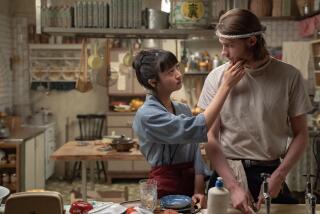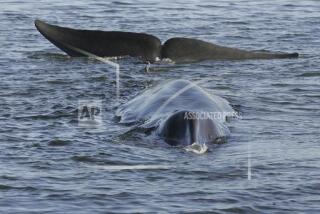Reykjavik wet, wild and a little weird
- Share via
Reykjavik, Iceland — “The smoked puffin is out of season right now, but other seabirds and whale are available tonight,” said a svelte blond waitress after I had taken a seat at Thrir Frakkar restaurant. Frankly, I’d been expecting even more bizarre offerings.
Days earlier, I had asked an Icelandic friend about sampling local foods on my weeklong trip here last summer.
“Our cuisine dates back to the Vikings,” Petur had told me, “and, like them, we still eat sheep’s blood pudding rolled in lard and sewn up in the stomach, jellied sheep’s head, called svid, seal flippers, rotten shark and our personal favorite -- pickled ram’s testicles.”
I checked Thrir Frakkar’s menu and was relieved to see none of those. I settled for sauteed cod.
Uncovering the quirky and bizarre beneath Iceland’s charming, squeaky-clean Nordic veneer became the theme of my weeklong visit last summer to this island in the middle of the North Atlantic. After all, there were bound to be idiosyncrasies in a country where the winds are so strong that they blow the hands off church clocks, where volcanoes punch holes through icecaps and where, in 1783, the world’s biggest lava flow in recorded history followed on the heels of a bubonic plague pandemic that killed two-thirds of the population.
Not surprisingly, Icelanders are a stoic people. And despite the spectacular, harsh environment they inhabit, they enjoy a modern, high standard of living.
Iceland is one of the planet’s youngest countries, still being formed by 200 active volcanoes spouting lava along the mid-Atlantic rift that is tearing the ocean floor in two. It is about the size of England but has only 280,000 people. Half of all Icelanders reside in Reykjavik, the capital.
The only metropolis in Iceland, Reykjavik is an exotic but easy place to visit. Nearly everyone speaks English, and it has the feel of a small country town. Its downtown is compact and centered around the historic part of the city, alongside a small lake called Tjornin, or “the Pond.”
I arrived late on a Saturday night into a Reykjavik I didn’t recognize. When I had left the city on a Wednesday for a hiking trip in the countryside, it had been a quiet, business-like city with a no-nonsense air of efficiency.
Now, on my return well after midnight, streets were bumper to bumper with cars. I fought my way through lines of people waiting for restaurant tables and clusters of Icelanders smooching and dancing outside cafes and in the middle of parks. Sidewalks were crowded with trendy partyers rigged head to toe in black and chatting earnestly into matchbox-size cellphones.
Since the mid-1990s, when the economy boomed and leading-edge musicians such as Bjork became popular internationally, Reykjavik has had a reputation as a hedonistic hub that draws jet-setting New Yorkers, Londoners and Germans for weekend jaunts of round-the-clock partying.
To avoid a fellow lurching from a cab with a half-pint of beer in his hand, I ducked into Cafe List, one of the dozens of ordinary daytime cafes that at 11 p.m. on weekends become discos throbbing with Eurobeat.
Inside, I sipped a local schnapps called Black Death, which made my gums tingle, as I watched a belly dancer gyrate to Algerian hip-hop. Inspired, two blonds abandoned their boyfriends, blouses and bras, and joined in. The trio snaked among tables in a kind of Middle-Eastern conga line.
This was a typical Saturday night in Reykjavik, the night clerk said when I returned to my hotel.
A calmer side of the city
Sunday morning dawned sunny, bright and quiet, more like the Reykjavik I was familiar with. The streets were deserted as I guided a bicycle rented at the tourist office onto one of the many well-marked bicycle paths circling the city.
I followed the seashore out of town, passing the pier where whale-watching and whale-catching boats were moored side by side. (Iceland resumed hunting Minke whales in 2003.)
I skirted the Pond and headed toward a pool built into the sand to capture natural geothermal bubbling water. In Iceland, natural hot springs are tapped to generate electricity, supply homes with hot water and melt ice and snow from under city sidewalks.
By the time I had stopped at the Cafe Nautholl for a hot bowl of seafood chowder, rain was washing the windows. So I did what all sensible Icelanders do when it rains -- as it does frequently here. I jumped on my bike and headed for one of the city’s 11 public outdoor geothermal swimming pools, each with a series of steaming pools at various temperatures. Because I hadn’t brought my own, I rented a swimsuit and towel, then coddled myself in a blanket of steam as refreshingly cold rain dripped on my face.
I started the next day in Sandholt Bakery on Laugavegur Street, clutching a clipping titled “Icelandic Bakeries for Dummies” that I had ripped out of Icelandair’s in-flight magazine. I pointed at a picture of vinarbraud, a Danish with a custard center and hidden globs of marzipan in flaky pastry. I also purchased a loaf of day-old bread, as instructed by the woman at the front desk of the Hotel Odinsve, then walked down the street to pick up a latte at Cafe Tar, where the staff had recently scored a second prize at the World Barista Championships.
From there, I headed toward the landmark Hallgrimskirkja Lutheran Cathedral, which towers above the town, its concrete bulk rising in columns that resemble organ pipes. The church is stark and overwhelming. But alongside, I found a hidden entranceway that led to a walled enclosure and the Einar Jonsson Sculpture Museum’s outdoor art garden. It proved to be the best place near the Arctic Circle to have breakfast amid thought-provoking contemporary sculpture while listening to 8 a.m. church bells and birds.
In fact, after breakfast I went to the birds. Reykjavik is an urban enclave in a wild country, and nature often appears downtown. The Pond attracts an astounding assortment of local and migratory birds that wing in from Siberia, Greenland and Europe. There are ducks, storks and geese, and it was for them I had bought the day-old bread.
Architectural style extremes
Alongside the Pond is the City Hall complex, which squats over the water in a strange melange of architectural styles -- heavy doses of bleak Stalinesque concrete structures and contemporary glass buildings. Then practically next door are quaint older houses and shops, clad in corrugated iron and often adorned with dormers and curlicue Victorian gingerbread trim. They’re painted in bright colors like orange and purple to cheer the populace, I was told, during the eight dark months of winter. In summer, it’s light nearly all day long, and temperatures are in the 50s and 60s.
My favorite building style was what I dubbed the “Jules Verne school of architecture.” The sci-fi author set his “A Journey to the Center of the Earth” in Iceland. “A town of two bleak depressing avenues” where most people are busy drying and salting cod, was his brief summary of the city. Local architects seem smitten with the riveted-steel spacecraft look.
The city’s main liquor store is a contemporary design with a vaulted ceiling of riveted steel plates that make the place feel like the interior of a bank safe, which may be appropriate given the notoriously high price of alcohol here.
The same style shows up in the Reykjavik Art Museum, a former waterfront warehouse for salt, which went with all that cod brought into adjacent piers. High concrete ceilings and industrial doors in the galleries surround an open courtyard. On display when I visited was “Lobster or Fame: Two Decades of Bad Taste,” Bad Taste being the mid-’80s cultural-experiment label that helped launch Bjork.
Reykjavik’s rich cultural offerings include the National Museum, the Museum of Photography and the National Art Gallery, which is too small a venue for a country with such a long tradition of creativity.
The Volcano Exhibition attempts to re-create the sensation of standing alongside an active volcano inside four walls of a downtown building.
There is also a museum in an odd, round building that combines a hot-water storage tank with one of the city’s best and costliest restaurants on top. La Perla rotates as you dine. When first opened, it rotated too quickly and patrons suffered motion sickness. That’s been fixed, but the displays of historical figures engaged in acts of warmongering and pillage from Iceland’s brutal past in the adjoining museum left me a little queasy.
My favorite art in Reykjavik was public, especially Keflavik International Airport’s baby Concorde hatching from a cracked egg -- of riveted aluminum, of course -- that resembled a jet engine housing, and a stylized Viking ship that looked more like a multilegged metallic bug crawling onto the waterfront.
It’s fascinating, and weird. Like Reykjavik itself.
*
(BEGIN TEXT OF INFOBOX)
A cool place to visit
GETTING THERE:
From LAX, connecting service to Reykjavik (with change of plane to Icelandair) is available on Northwest, Delta, Continental, British, American, Virgin Atlantic and Air New Zealand. Restricted round-trip fares begin at $878.
TELEPHONES:
To call the numbers below from the U.S., dial 011 (the international dialing code), 354 (country code for Iceland) and the local number.
WHERE TO STAY:
Hotel Nordica, 2 Suourlandsbraut; 444-5000, fax 444-5001, www.icehotel.is. An Icelandair hotel and a 25-minute walk from downtown. Has a chic lobby, bar and restaurant. Doubles $425.
Hotel Odinsve, 511-6200, fax 511-6201, www.hotelodinsve.is. A quiet residential hotel in the city center. Doubles $335, including breakfast.
Hotel Cabin, 511-6030, fax 511-6031. Simple, modern motel accommodation about 1 1/4 miles from city center. Doubles $195, including breakfast.
WHERE TO EAT:
Thrir Frakkar, 14 Baldursgata; 552-3939, www.3frakkar.com. An elegant warren of candlelit dining rooms in an old house on a residential street. Excellent traditional Icelandic cuisine including whale. Main courses $33-$46.
Vid Tjornina, 3 Templarasund; 551-8666, www.islandia.is/vidtjornina. Seafood restaurant with many traditional dishes. Main courses $38-$75.
Cafe Solon, 7a Bankastraeti; 562-3232, www.solon.is. Chic cafe with tasty, open-faced sandwiches for lunch. Lunches $8-$17.
Vegamot, 4 Vegamotastigur; 511-3040, www.vegamot.is. Popular, casual and reasonably priced bistro with an emphasis on healthful foods and salads. Lunches $16-$21.
TO LEARN MORE:
Reykjavik Tourist Information Centre, 590-1500, www.visitreykjavik.is.
Icelandic Tourist Board, (212) 885-9700, www.icelandtouristboard.com.
-- Margo Pfeiff
More to Read
Sign up for The Wild
We’ll help you find the best places to hike, bike and run, as well as the perfect silent spots for meditation and yoga.
You may occasionally receive promotional content from the Los Angeles Times.






